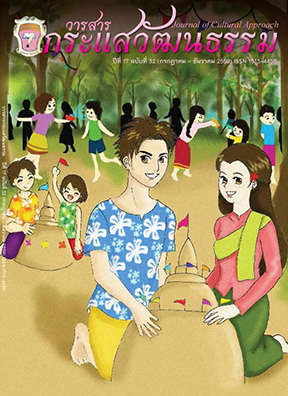เพลงทับในรูปแบบการแสดงหนังตะลุง : กรณีศึกษานายทับในคณะของนายหนัง ตะลุงที่ได้เป็นศิลปินแห่งชาติ
Main Article Content
บทคัดย่อ
การวิจัยเรื่องเพลงทับหนังตะลุง : กรณีศึกษานายทับในคณะของนายหนังตะลุงศิลปินแห่งชาติใช้ระเบียบวิธีวิจัยทางมานุษยดนตรีวิทยา มีวัตถุประสงค์เพื่อศึกษาบริบททางดนตรีที่เกี่ยวข้องกับทับในสังคมและวัฒนธรรมของภาคใต้ลักษณะเฉพาะทางดนตรีของเพลงทับหนังตะลุง และความสัมพันธ์ระหว่างการบรรเลงทับกับการแสดงหนังตะลุง โดยศึกษาจากนายทับในคณะของนายหนังที่ได้เป็นศิลปินแห่งชาติจำนวน 6 คณะ ผลการวิจัยพบว่า ทับ เป็นเครื่องดนตรีที่จัดอยู่ในกลุ่มกลองกอบลิท (Goblet drum) ทางภาคใต้ใช้ประกอบการละเล่นลิมนต์ โนรา และหนังตะลุง ทับที่ใช้บรรเลงประกอบหนังตะลุงมีจำนวน 2 ใบ เรียกชื่อว่าทับหน่วยผู้และทับหน่วยเมีย ลักษณะทางกายภาพของทับมี 2 ส่วน คือ หน้าทับและหุ่นทับ ในทางปฏิบัติมีการใช้เสียงทับบรรเลงจำนวน 5 เสียง คือ ฉับ เทิงหน่วยผู้ เทิงหน่วยเมีย ติ๊ด และทึด
ด้านลักษณะเฉพาะทางดนตรีพบว่าจังหวะทับแบ่งเป็น 3 กลุ่ม คือ จังหวะตำเหนิน จังหวะเชิดรูปเฉพาะ และจังหวะขับบท ดำเนินจังหวะโดยการซ้ำและแปรลักษณะจังหวะ มีการใช้ลักษณะจังหวะเฉพาะแบบ และการใช้จังหวะขัด แบ่งการใช้เสียงทับเป็น 2 กลุ่ม คือ กลุ่มเสียงหลัก ประกอบไปด้วยเสียงฉับ เทิงหน่วยผู้ และเทิงหน่วยเมีย กลุ่มเสียงรอง ประกอบไปด้วยเสียงติ๊ดและทึด การบรรเลงส่วนใหญ่ใช้เสียงสูงและเสียงต่ำสลับกันตลอดทั้งเพลง โดยพบว่าการบรรเลงทับมีความสัมพันธ์กับการแสดงด้านการบรรเลงประกอบพิธีกรรม บรรเลงประกอบบทเพลง บรรเลงประกอบการขับบท และบรรเลงประกอบบทบาทในฉาก
Article Details
Proposed Creative Commons Copyright Notices
1. Proposed Policy for Journals That Offer Open Access
Authors who publish with this journal agree to the following terms:
- Authors retain copyright and grant the journal right of first publication with the work simultaneously licensed under a Creative Commons Attribution License that allows others to share the work with an acknowledgement of the work's authorship and initial publication in this journal.
- Authors are able to enter into separate, additional contractual arrangements for the non-exclusive distribution of the journal's published version of the work (e.g., post it to an institutional repository or publish it in a book), with an acknowledgement of its initial publication in this journal.
- Authors are permitted and encouraged to post their work online (e.g., in institutional repositories or on their website) prior to and during the submission process, as it can lead to productive exchanges, as well as earlier and greater citation of published work (See The Effect of Open Access).
Proposed Policy for Journals That Offer Delayed Open Access
Authors who publish with this journal agree to the following terms:
- Authors retain copyright and grant the journal right of first publication, with the work [SPECIFY PERIOD OF TIME] after publication simultaneously licensed under a Creative Commons Attribution License that allows others to share the work with an acknowledgement of the work's authorship and initial publication in this journal.
- Authors are able to enter into separate, additional contractual arrangements for the non-exclusive distribution of the journal's published version of the work (e.g., post it to an institutional repository or publish it in a book), with an acknowledgement of its initial publication in this journal.
- Authors are permitted and encouraged to post their work online (e.g., in institutional repositories or on their website) prior to and during the submission process, as it can lead to productive exchanges, as well as earlier and greater citation of published work (See The Effect of Open Access).
References
[2] Figure 1. Conceptual of Framework. Adapted from Thub Rhythmic Patterns in Shadow Puppet Performances : The Case of Thub Musicians Performing in the Ensembles of National Artist Puppeteers [Master’s thesis] (p.7), by P. Chaiboon, 2016, Thailand. Mahidol University.
[3] Figure 2. Comparison of goblet and thub. Adapted from Thub Rhythmic Patterns in Shadow Puppet Performances: The Case of Thub Musicians Performing in the Ensembles of National Artist Puppeteers [Master’s thesis] (p.38), by german-toasting-glasses.com and P. Chaiboon, 2016, Thailand. Mahidol University.
[4] Figure 3. Physical of thub. Adapted from Thub Rhythmic Patterns in Shadow Puppet Performances : The Case of Thub Musicians Performing in the Ensembles of National Artist Puppeteers [Master’s thesis] (p.43), by P. Chaiboon, 2016, Thailand. Mahidol University.
[5] Hnuthong, Udom. (1981). Music for Accompanying the Nang Talung. In U. Hnuthong (Ed.), Southern Thai Folk Music. (pp. 42-52). Bangkok : The Institute for Southern Thai Studies.
[6] Leangsomboon, Wirat. (2001). Pleang Hom Rong Nora, Traditional Music for Native Dance in Nakhon Si Thammarat Province, Thailand. Thesis, Master of Art (Music), Mahidol University.
[7] Pancharoen, Natcha. (2008). Form and Analysis (4th ed.). Bangkok : Katekarat Press.
[8] Petchkaew, Chuan. (2003). Nang Talung in Thailand. Surat Thani : Faculty of Education, Suratthani Rajabhat University.
[9] Phongphaibun, Suthiwong. (n.d.). Nang Talung. Songkhla : Southern Region Language and Cultural Center.
[10] Pidokrajt, Narongchai. (2012). Ethnomusicology. Nakhon Pathom : n.p.
[11] Satsanguan, Ngampit. (2000). Principle of Cultural Anthropology. Bangkok : Department of Sociology and Anthropology, Faculty of Political Science, Chulalongkorn University.
[12] Sreesamuth, Surasit. (2006). The Principal Songs in Limon, a Shamanistic Ritural at Songkhla Province. Thesis, Master of Art (Music), Mahidol University.
Interview
[13] Oramut, Chin. (2015, July 6). National Artist of the Performing Arts (Nang Talung) in 1989.
[14] Subsin, Watee. (2015, July 29). Vice Director, Research and Development Institute of Nakhon Si Thammarat Rajabhat University.

